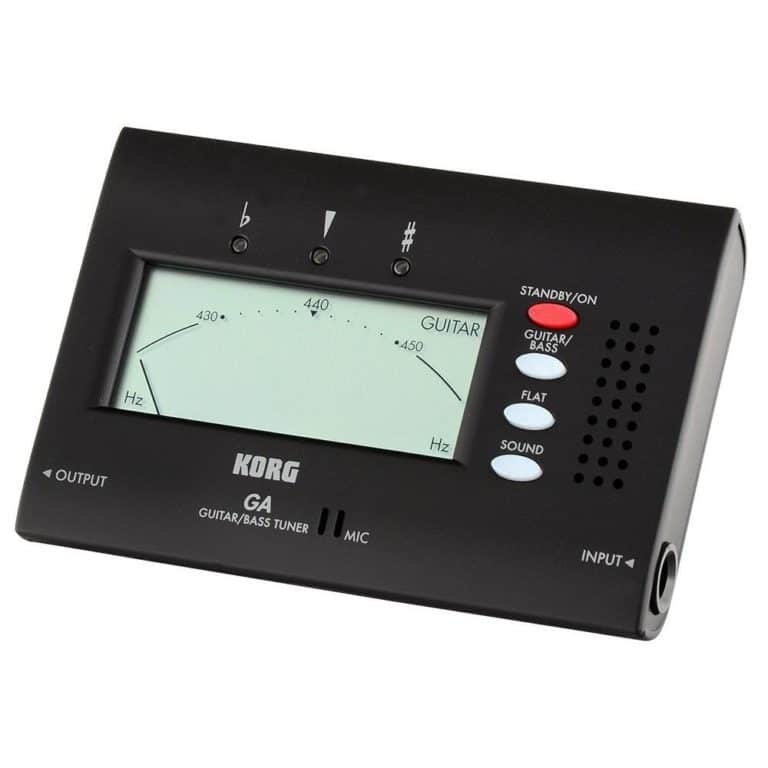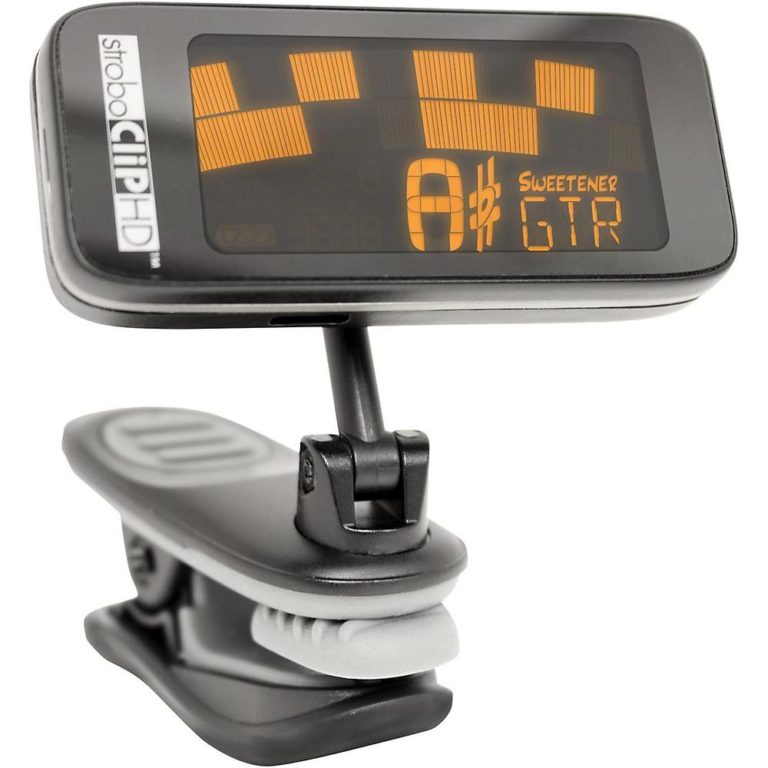Best Guitar Tuner
One of the most common things you gotta do when you get a guitar is learn how to tune it. Whether you’ve picked up your old guitar after a while and need to get it ready for playing or just bought a new one – tuning is a mandatory requirement for any guitar player. Even the top pros have to do it at home where they don’t have an army of people getting their axes ready for a gig.
In modern times, it’s quaint to tune by ear, so we have a bunch of cool tech toys designed to make tuning easy. They come in various shapes and sizes, and we’ve picked out an interesting variety of choices for you to check out.
So, without further ado, here are our best guitar tuners:
Snark – SN5
5.0 out of 5.0 stars
Although the handheld tuners had a quite a number of qualities and advantages, their main flaw was that they could not be used in a loud environment, making them a great ‘’stay-at-home’’ option. So, as a result of that, we were gifted with a much more convenient option that didn’t pick up any unwanted noise around us in the form of a clip-on tuner.
Snark – SN5, being a truly great representative of the bunch, packs a lot of cool options within it’s rather unconvincingly plastic-looking outer shell. Namely, whether you are in your bedroom, tuning up for the song-writing session in your comfy pajamas, or rocking the stage in a smoky club with dimmed lights, the brightness of the display and the vivid colors will be strong enough for your eyes to see, no matter how poor the lighting may be. You can place the tuner on the either side of your headstock and it will stick equally well, while the rotatable screen can go full 360 degrees, making it an insanely handy piece of gear. Another shockingly cool feature at this price range is the frequency range that the tuner can pick up. Other than the electric and acoustic guitars, this baby can be used to tune bass guitars and violins as well. The way this bad boy picks up the signal is by a microphone and a spezio sensor for tuning.
Highly affordable, insanely versatile, the right bang for your buck! Recommended for all of you out there that do not want to worry about losing or damaging some of the more expensive options.
Boss TU-3 Chromatic Tuner
Best Value Pick
Arguably, the most famous guitar tuner in a form of a pedal. Being a real industry standard, it is a very common addition to the pedalboards of many professional guitar players. Improving upon the TU-2 Boss model, this stompbox is even more precise when it comes to the pitch accuracy. This classic design does not only look legendary, it is also a highly durable and sturdy piece of equipment. With the highly bright display, it makes it visible even in the shiniest of sunlight, so that should not be a worry. Although, the absence of the true bypass unit may be a turn-off for some, the buffered bypass unit makes it a great addition for any kind of longer signal chain. The flat mode of this stomper supports drop tunings up to six semitones below the standard A 440 pitch.
If you are not the sound obsessed perfectionist (meaning that you don’t mind the absence of the true bypass), and the price tag is within your range, this is it! The true legend of the game.

Mugig Clip-on
What a lovely little piece of equipment this is! First things first, the versatility of this tuner is insane. It operates in five different modes being: guitar, bass, violin, ukulele and chromatic tuning options. The sound vibration sensor is calibrated at 430-450 Hz. The sensor is highly sensitive to the input it receives from the guitar itself, but it filters out all of the unwanted noise that may want to creep up. The head of the tuner is rotatable and it rotates around all of the 360 degrees. And if that was not enough to persuade you, the auto power off option is something that will definitely blow your mind. Namely, if you forget to turn off your tuner (which is something that all of us guitar players are guilty of), it will automatically turn itself off after 5 minutes since the last
musical note was detected. Mind. Blown.
With its small and handy size, insanely cool features and the environmentally-friendly ABS plastics used to create this baby, this may just be one of the coolest options out there on the market currently.

Korg GA-40 Guitar And Bass Tuner
If you are a beginner and you want a reliable tuner that’s simple to use, then look no further! This is the holy grail of the entry-level tuners you are looking for. With a genuinely elegant design and pocket-size dimensions, this one can be a great option to put on your lap and tune your acoustic guitar. However, if you are an electric guitar player, or if you are surrounded by noise, there is also an input jack that you can use to directly plug your guitar into. It also has an output jack, meaning that you can leave it plugged in while using your amplifier as well. Also, as the name rather suggests, this tuner can be used to tune bass guitars as well.
The main draw of this guitar tuner is its simplicity. You don’t have to be the seasoned veteran in order to use this handheld machine, which makes it great for any level guitar player.
TC Electronic Polytune 3
So far on this list, we have had the representatives of the clip-on tuner family, stompbox tuner family, a handheld option, chromatic tuner, etc…But this one brings something completely different to the table. It is a polyphonic tuner. It is something that is the latest word of technology in the world of guitar tuners. Namely, what makes them different is the option to strum all of the six strings of your guitar and tune them at once. Before we go any further, let just make things clear and say that this tuner comes with a pretty hefty price tag, which would be a huge no-no to a lot of you readers out there, but a very interesting addition to this list, nonetheless.
Besides its stunning pitch accuracy, one of the coolest options when it comes to this pedal is the fact that you can switch between the true bypass and the buffered bypass modes. Also, if you are in the situation in which the technological bonanza in the form of a polyphonic tuning mode is not what you desire, you can also switch to the chromatic mode and spare yourself of the unnecessary fuss.
A truly magnificent tuner and an incredible technological innovation, If you are willing to pay its larger price tag.
Korg Pitchblack Advance
Definitely, the best-looking cat on the block. Well, on this list, at least. The Korg company itself reckons that they have made what they call ‘’the best tuner pedal’’ known to man. Behind the pretentious words, there is quite a case to be made for that claim. No wonder, their life would be on the line, coming up with such slogans and not delivering the goods. The absolute rockstar of this pedal is the long lasting 60 hour battery life of an alkaline 9 volt battery. But besides that, the ever-so-crucial visibility of the display is incredibly good for both dark club and direct sunlight scenarios. The true bypass unit rounds up this great set of features. Some may argue that the buffered bypass unit would be more desirable, but it really depends on your situation and needs. If you are running your guitar signal through a huge number of pedals on your pedalboard, that just might be the case. But as aforementioned, it really depends on your situation and needs. Now, the only real downfall of this baby would be its accuracy which is not of a top-tier kin.
With its good looks, solid build and durable battery life, this one is a true road dog that is a dream come true for any touring guitar player.
Real Tuner – Chromatic Clip-on Tuner
Another good looking stud on our list. Its stylish outer cover is embellished with the very bright display that makes it visible and optimal for use in any kind of situation you may find yourself in. The display is rotatable in 360 degrees which is another great addition. The vibration sensor is quite sensitive and reactive, making it a highly accurate guitar tuner. Besides that, its wide tuning range is another highly desirable feature of this clip-on tuner. Not only does its battery life last longer than the average, but there’s also a guarantee that lasts for three years, in case something goes wrong. With a tuner built like this, nothing should really go wrong, but hey, a great option to have nonetheless.
A great all around clip-on tuner with all of the important features that make it one of our top suggestions.
Boss TU-EX Chromatic Tuner
Nothing can beat this one in the studio situation. Its highly precise analog needle shows even the slightest offsets in the pitch, which makes this chromatic tuner a great tool to use when recording. Not only can it be used to tune guitars, but a whole other set of string instruments, pianos, etc…This is a tuner in which the best of both worlds come together. The perfect precision you will get, combined with the simplicity of this machine makes it a true superstar in the world of guitar tuners. This top-of-the-range beauty is an improved version of the legendary TU-12 tuner by Boss. However, the high performance does not come without the high price. While that can be a minus for some, this is the best option on the market for the professional studio musicians and a true must have!
Highly recommended!



Real Tuner – Chromatic Clip-on TunerPeterson Stroboclip Clip-on Strobe Tuner
If you are looking for strobe tuners, Peterson is always a way to go. Strobe tuners are the oldest form of electronic tuners and Peterson made their name making these types of machines. This one is a highly precise guitar tuner. The tuning process consists of comparing the note that you played with the perfect reference frequency. The accuracy is off the charts with this one. Another great feature is that you do not have to be in a silent room in order to tune your instrument, since it does not pick up any of the unwanted noise!
Simple, accurate and very effective!
Fender Tune
Now that we have stepped into some ‘’outside the box’’ tuning solutions territory, we present you with the first tuning app on our list. Not only is it free, but it is also available on the iOS and Android platforms. What Fender managed to do with this app is to create a fairly simple, yet highly versatile application that is very beginner friendly, that can also be of use to any level guitar player. While using this app, you can switch between chromatic and manual modes, according to your needs. But the coolest option when it comes to the modes available is the option to create custom tunings and use them when needed.
The main flaw of this app would be its accuracy. While it is definitely not among the most precise tuners out there, it can be upgraded with an in-app purchase which makes the pitch accuracy much more precise. Some of the other upgrade purchases can equip you with a metronome, drum beats, chord identifier and scale diagrams.
All in all, a tremendous app that proves once again that Fender is at their best at the head of the advances and innovations in music.
Why Do You Need a Tuner?
Back when I was a teenager, a friend of mine bought his first guitar and started learning by himself. Back then, we were
avid thrash metal fans so he tried doing some Metallica and Megadeth covers straight away, but something didn’t seem right, apart from his lack of skill. He would tell me that his guitar just wasn’t producing the right sounds. He called me and asked me to come over and check what was going on, since I was a bit more experienced. I could already guess what the problem was, but seeing it was something else altogether. He just turned all the tuning pegs in the same direction and figured that was all there is to it.
I shook my head in disapproval, mocked him a bit, then told him a few things about guitar tuning. I didn’t know much at the time, but enough to slowly standard tune his new guitar by ear, using a YouTube video for reference. It was far from perfect EADGBE tuning, but A LOT better than what he had before. I think that everybody had their own mnemonic acronym for standard tuning when they started off, mine was Eat All Donuts Get Big Easy, and that’s what I taught my friend as well.
In case this little story wasn’t self-explanatory – you need a tuner if you’re using a guitar for anything other than an ornament on a wall.
What Does A Guitar Tuner Do?
Duh, it tunes your guitar, but let’s take a bit of a closer look. It’s a small electric device or a pedal, usually powered by batteries or via adapter/power supply, that lets you tune your guitar (or in some cases other instruments) to your desired tuning. It compares the pitch of your string to the premade pitch inside the device and lets you know how far off the guitar’s pitch is from the real thing.
All of this is usually displayed on a built-in screen on the tuner itself, and the screens usually shine different colors, depending on your pitch. For example, if you want to pitch your guitar standard and start off with E, if you’re far off from E, the display will glow a red light when you strum your string, and as you get closer to that perfect pitch, it will become yellow, and then finally green when you can proceed with the next string.
There are two main types of tuners: non-chromatic, and chromatic. Non-chromatic tuners offer the most basic type of tuning and that is the “standard” Eat All Donuts Get Big Easy tuning which we mentioned earlier. Non-chromatic tuners are also exclusively used for guitars, since they only offer EADGBE tuning, standardized for six-string guitars. Chromatic tuners are a bit more complex, and they store and detect all twelve notes of the chromatic scale. A chromatic tuner is also used with instruments other than guitar, since they all use non-standard tunings. So if you own a, let’s say, violin, a chromatic tuner will do a great job.
Types of Tuners
Today, there’s a wide range of tuners on the market, and it’s never been easier and faster to tune a guitar. You can choose between a lot of tuner options, and we’ll mention several:
Handheld Tuners – Pretty much self-explanatory. If it’s made for an electric guitar, it usually comes with a standard jack, and if used for acoustic tuning, it has a built-in microphone. It’s usually the least accurate type of tuner, but it’s the cheapest and most convenient option.
Clip-On Tuners – A top pick for acoustic guitars. It has a built-in contact microphone that can also sense vibrations from the neck, so it nullifies background sounds. Also quite cheap and a bit more accurate than handheld.
Pedal Tuners – They look exactly like a regular effect pedal, but they’re used for tuning an electric guitar. Ideal for guitarists who’d like to tune their guitar on the fly, especially on stage.
Polyphonic Tuners – This is the newest kind of guitar tuners where you can check the tuning of all your strings with a single strum. First introduced by TC Electronics, you can read more about their awesome tuner among our top picks.
App Tuners – Also a relatively new addition to the tuning world, smartphone app tuners are growing in popularity, because they are usually free and convenient.
As you can see, there are all kinds of guitar tuners, this is just a part of it. And humanity keeps delivering novelties almost every day, it’s just in our nature. Musicians and artists in general are among the most creative folks out there, so who knows what kind of guitar tuner will see the light of day next. Can’t wait!
Tuning By Ear
When all fails, or when you just don’t have a tuner on you in a particular moment, and you’d like to tune your axe, there’s always tuning by ear. While many guitarists out there firmly claim that tuning by ear is the only “right” way to tune a guitar, that’s quite arguable. But a claim that it’s useful is definitely true. It actually trains your ear pitch, making you differentiate notes and the relationship between them more easily.
I highly encourage you to learn and ear tune your guitar. Do it from time to time and compare it with your tuner. After a while, you’ll be able to tell if you are out of tune even with a single strum. Try it for a couple of months, you’ll thank me later!

